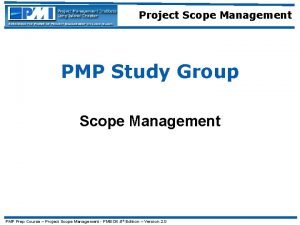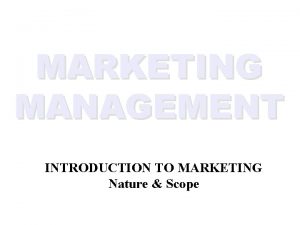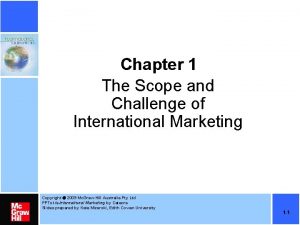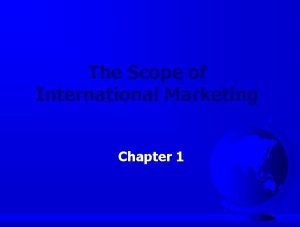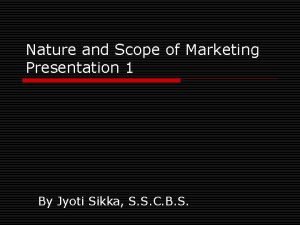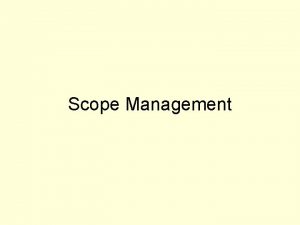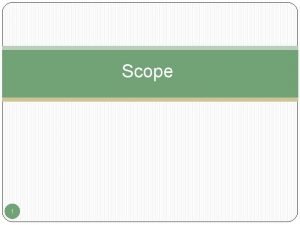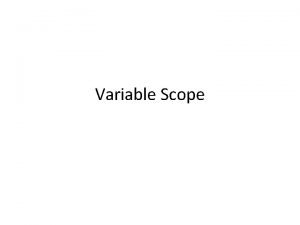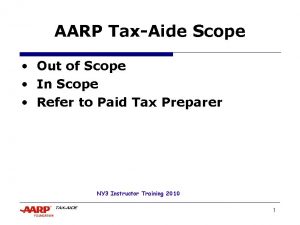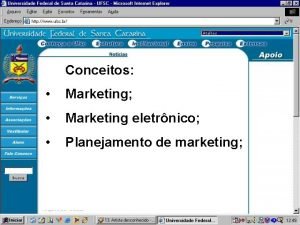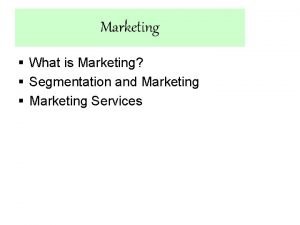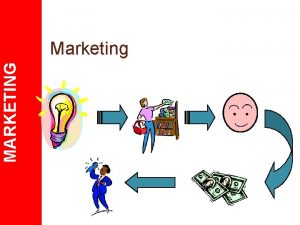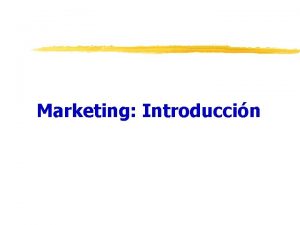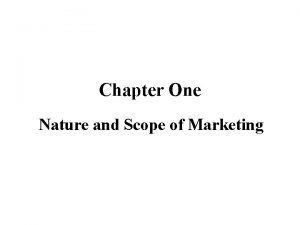CHAPTER 1 THE SCOPE OF MARKETING WHAT IS

























- Slides: 25

CHAPTER - 1

THE SCOPE OF MARKETING

WHAT IS MARKETING Marketing is an organizational function and a set of processes for creating, communicating and delivering value to customers and for managing customer relationships in ways that benefit the organization and its stakeholders. Social definition: living Delivering a higher standard of Managerial definition: The art of selling products

Marketing Management is the art and science of choosing target markets and getting keeping and growing customers through creating, delivering and communicating superior customer value.

EXCHANGE AND TRANSACTION Exchange is the process of obtaining a desired product from someone by offering something in return. 1. There at least two parties. 2. Each party has something that might be of value to the other party. 3. Each party is capable of communication and delivery. 4. Each party is free to accept or reject the offer. 5. Each party believes it is appropriate or desirable to deal with the other party.

Transaction A transaction is a trade of values between two or more parties. Transfer In a transfer, one party gives something to the other party, but does not receive anything tangible in return.

WHAT IS MARKETED GOODS PLACES SERVICES PROPERTIES EVENTS ORGANIZATIONS EXPERIENCES INFORMATION PERSONS IDEAS

WHO MARKETS? MARKETERS & PROSPECTS A marketer is someone who seeks a response from another party, called the prospect. Marketers are responsible for demand management, they seek to influence the level, timing and composition of demand to meet the organization’s objectives.

Eight demand states 1. Negative demand 5. Irregular demand 2. Nonexistent demand 6. Full demand 3. Latent demand 7. Overfull demand 4. Declining demand 8. Unwholesome demand

KEY CUSTOMER MARKETS Consumer markets Global markets Business markets Nonprofit and governmental markets

MARKETPLACES, MARKETSPACES, METAMARKETS • The Marketplace is physical. • The Marketspace is digital. • A Metamarket can be described as a cluster of complementary products and services that are closely related in the consumer minds but are spread across a diverse set of industries.

HOW BUSINESS & MARKETING ARE CHANGING Changing technology Customization Globalization Heightened competition Deregulation Industry convergence Changing technology Retail transformation Customer empowerment Disintermediation

COMPANY ORIENTATIONS TOWARD THE MARKETPLACE

THE PRODUCTION CONCEPT Consumers will favor products that are widely available and inexpensive. THE PRODUCT CONCEPT Consumers will favor those products that offer the most in quality, performance and innovative features.

THE SELLING CONCEPT Consumers and businesses will ordinarily not buy enough of the organization’s products unless it undertakes a aggressive selling and promotion effort. THE MARKETING CONCEPT The key to achieving organizational goals consists of the company being more effective than competitors in creating, delivering and communicating superior customer value to its chosen target markets.

THE HOLISTIC MARKETING CONCEPT The holistic marketing concept is based on the development , design, and implementation of marketing programs, processes, and activities that recognizes their breadth and interdependencies. Holistic marketing recognizes that “everything matters” with marketing.

Holistic marketing dimensions Internal marketing Integrated marketing Holistic marketing Socially responsible marketing Relationship marketing

• Relationship • marketing • • Integrated marketing Customers Employees Marketing partners Members of the financial community • Communications • Products & services • Channels Marketing mix Product Price Promotion Place (Customer solution) (Customer cost) (Communication) (Convenience)

Internal marketing Socially responsible marketing • Marketing department • Senior management • Other departments • • Ethics Environment Legal community

MARKETING TRENDS AND MARKETING TASKS

SHIFTS IN MARKETING MANAGEMENT FROM TO marketing does the marketing everyone does the marketing FROM TO organizing by product units organizing by customer segments FROM TO making everything buying more goods & services from outside FROM TO using many suppliers working with fewer suppliers in a “partnership”

FROM TO relying on old market positions uncovering new ones FROM TO emphasizing tangible assets emphasizing intangible assets FROM TO building brands through advertising building brands through performance and integrated communications FROM attracting customers through stores and salespeople making products available online TO FROM TO selling to everyone trying to be the best firm serving well defined target markets

FROM TO focusing on profitable transactions focusing on customer lifetime value FROM TO a focus on gaining market share a focus on building customer share FROM TO being local being “Glocal” – both global and local FROM TO focusing on the financial scorecard focusing on the marketing scorecard FROM TO focusing on shareholders focusing on stakeholders

MARKETING MANAGEMENT TASKS Developing marketing strategies and plans Capturing marketing insights Connecting with customers Building strong brands

Shaping the marketing offerings Delivering value Communicating value Creating long-term growth
 Scope management pmp
Scope management pmp Io2br3
Io2br3 What is marketing nature scope and importance
What is marketing nature scope and importance What is the scope of marketing
What is the scope of marketing International marketing scope
International marketing scope International political situation
International political situation Scope of international marketing
Scope of international marketing Developing a global vision through marketing research
Developing a global vision through marketing research Nature and scope of marketing
Nature and scope of marketing Explain the nature and scope of marketing
Explain the nature and scope of marketing Scope of agricultural marketing
Scope of agricultural marketing Hình ảnh bộ gõ cơ thể búng tay
Hình ảnh bộ gõ cơ thể búng tay Ng-html
Ng-html Bổ thể
Bổ thể Tỉ lệ cơ thể trẻ em
Tỉ lệ cơ thể trẻ em Voi kéo gỗ như thế nào
Voi kéo gỗ như thế nào Chụp tư thế worms-breton
Chụp tư thế worms-breton Chúa yêu trần thế alleluia
Chúa yêu trần thế alleluia Môn thể thao bắt đầu bằng chữ f
Môn thể thao bắt đầu bằng chữ f Thế nào là hệ số cao nhất
Thế nào là hệ số cao nhất Các châu lục và đại dương trên thế giới
Các châu lục và đại dương trên thế giới Cong thức tính động năng
Cong thức tính động năng Trời xanh đây là của chúng ta thể thơ
Trời xanh đây là của chúng ta thể thơ Cách giải mật thư tọa độ
Cách giải mật thư tọa độ Phép trừ bù
Phép trừ bù độ dài liên kết
độ dài liên kết
